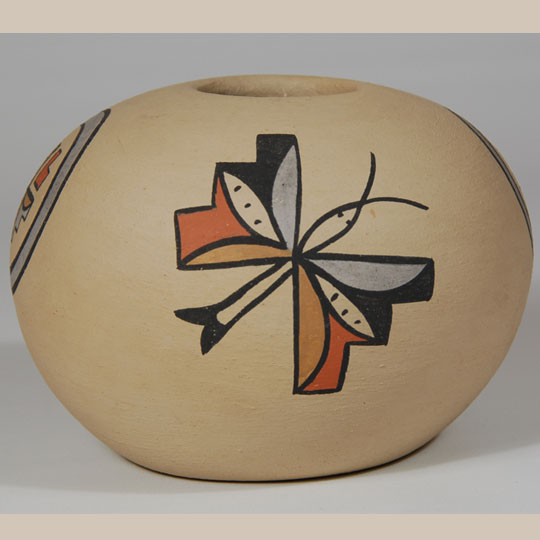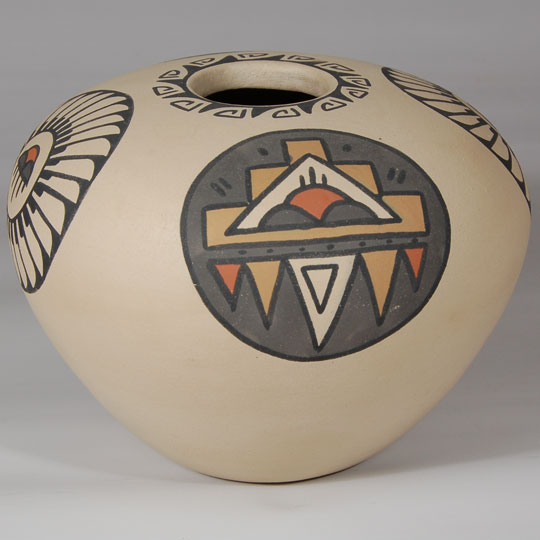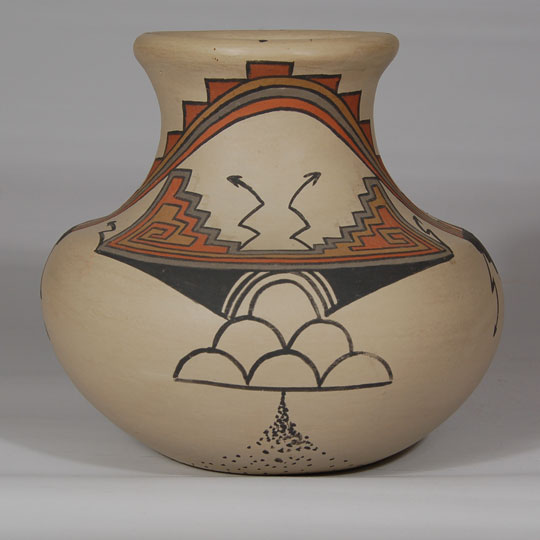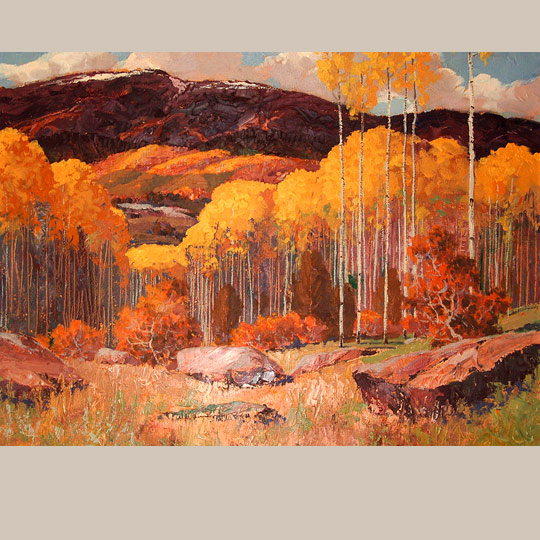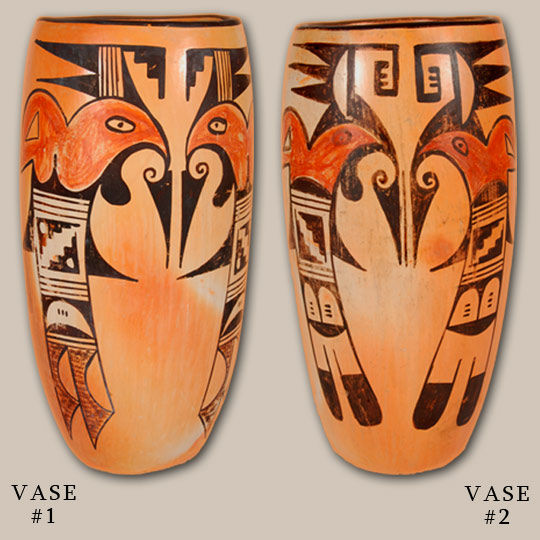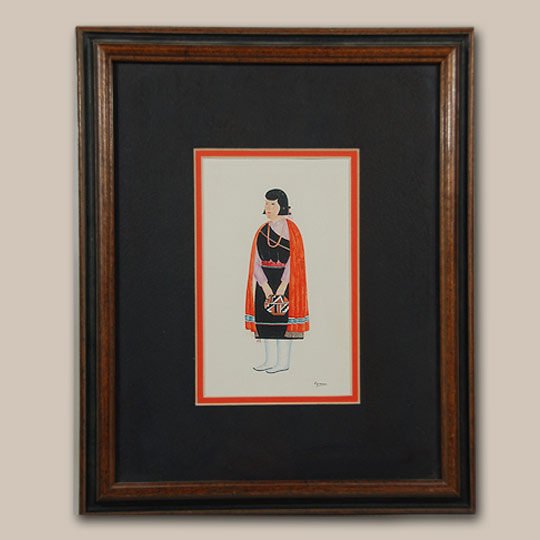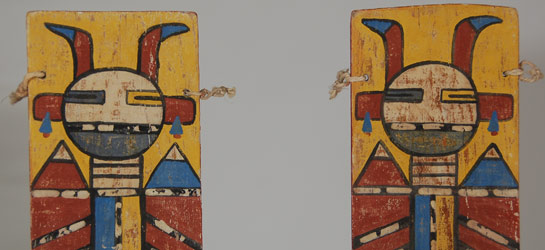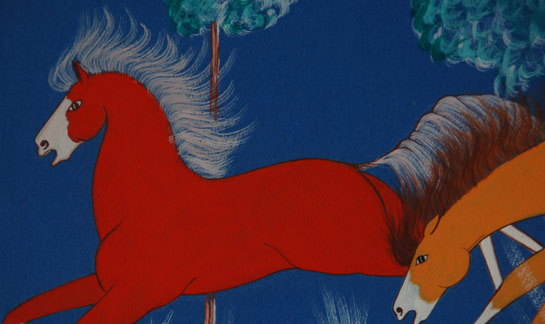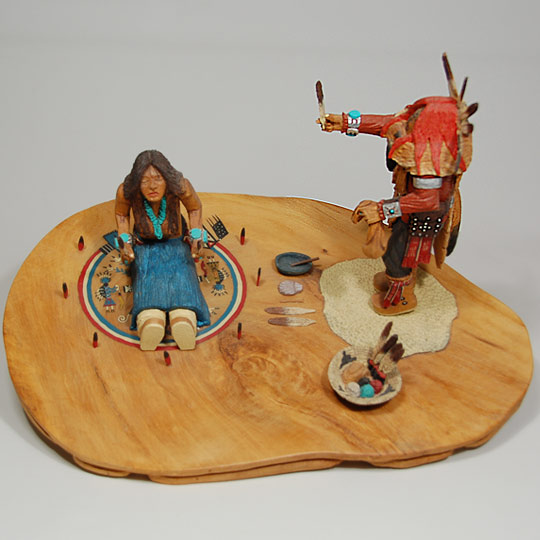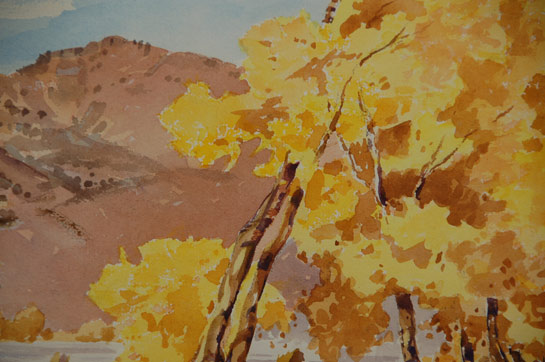Subject: Pojoaque Pueblo Matte-finish Polychrome Seed Jar
Mary Gutierrez is a member of the Talachy family of Pojoaque Pueblo but I have been unable to find any significant information regarding her. One would assume that she was related to Minnie Vigil and Lois Gutierrez because their style of pottery is similar in shape, design, and finish, but I can find no connection between them. This seed jar was most likely made in the 1960s as that is when most of the pottery in this collection was purchased.
Condition: original condition with the exception of a small adhesive mark where a piece of tape was removed near the base of the jar.
Provenance: from the collection of Katherine H. Rust
Subject: Pojoaque Pueblo Matte-finish Polychrome Seed Jar
Artist: Mary Talachy Gutierrez
Category: Contemporary
Origin: Pojoaque Pueblo
Medium: clay, pigments
Size: 3-5/8" tall x 5-1/8" diameter
Item # C3251E
Subject: Santa Clara Pueblo Polychrome Seed Jar by Minnie Vigil
Minnie Vigil is one of a family of talented potters. She and her sisters, Lois Gutierrez de la Cruz, Thelma Talache, and Gloria (Goldenrod) Garcia, are potters of distinction. Minnie has won awards at Santa Fe Indian Market for years in recognition of her fine workmanship. She specializes in Polychrome wares. Some of her pottery is slipped in red clay and stone polished and some is slipped in matte tan clay and not polished. This seed jar is of the latter style.
Minnie Vigil has produced exceptional pottery for a long time. She is recognized as one of the finest potters at Santa Clara Pueblo who is producing Polychrome wares. This jar is typical of her quality of work. It is well balanced and the painted decoration is beautifully executed. It is signed Minnie Santa Clara.
Condition: excellent condition
Provenance: from the collection of Katherine H. Rust
Recommended Reading: Pueblo Indian Pottery: 750 Artist Biographies by Gregory Schaaf
Subject: Santa Clara Pueblo Polychrome Seed Jar by Minnie Vigil
Artist: Minnie Vigil (1931-present)
Category: Contemporary
Origin: Santa Clara Pueblo
Medium: clay, pigments
Size: 4-5/8" tall x 6-1/4" diameter
Item # C3235L
Subject: Matte Painted Polychrome Jar
The combination of multiple colors and matte finish achieved by Lois and Derek de la Cruz results in a soft palette and pleasing visual sensation. They collect different colors of clay and minerals from nature which provides them with a wide-ranging palette for their painted designs. Precision in application of the painted design is a hallmark of this couple.
Lois is a daughter of Petra Gutierrez and sister to Gloria (Goldenrod) Garcia, Thelma Talachy, Lupita Gutierrez, and Minnie Vigil, all of whom are outstanding potters as well. Lois and Derek started working together in 1970. The jar is co-signed Lois-Derek.
The overall design concept on this jar is "rain." There are rain clouds dropping rain at the mid-body of the jar and clouds and lightning on the shoulder. Rainbows arch over the body designs.
Condition: the jar is in very good condition.
Provenance: from the collection of Katherine H. Rust
Recommended Reading: Pueblo Indian Pottery: 750 Artist Biographies by Gregory Schaaf
Subject: Matte Painted Polychrome Jar
Artist: Lois and Derek de la Cruz
Category: Contemporary
Origin: Santa Clara / Pojoaque Pueblos
Medium: clay, pigments
Size: 5-3/4" tall x 6-1/4" diameter
Item # C3235J
Subject: Navajo (Diné) Folk Art Wood Carving "Female Skinwalker"
This sculpture is of a Female Skinwalker, which, in Navajo legend, would be much rarer than male Skinwalkers. There are several varieties of Navajo witches, one of which is using his (rarely her) powers to travel in animal form. In some versions, men or women who have attained the highest level of priesthood are called "pure evil."
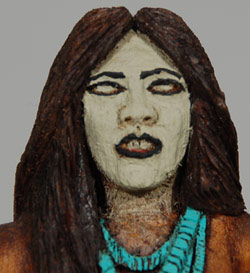 They are human beings who have gained supernatural power by breaking a cultural taboo. Specifically, a person is said to gain the power to become one upon initiation into the Witchery Way. Both men and women can become skinwalkers, but men are far more numerous. It is generally thought that only childless women can become witches.
They are human beings who have gained supernatural power by breaking a cultural taboo. Specifically, a person is said to gain the power to become one upon initiation into the Witchery Way. Both men and women can become skinwalkers, but men are far more numerous. It is generally thought that only childless women can become witches.
Larry Jacquez (pronounced Hackus) is a Navajo folk art carver who specializes in the unusual. He is known to have carved and painted extraordinary objects accurately depicting the Yeis, Navajo mythology, and the dances and escapades of skinwalkers. The Rosenaks stated that they were surprised by the appearance of skinwalkers in his work, and doubtful of their very existence, but Jacquez told them that "evil witches do exist."
Some Navajo also believe that skinwalkers have the ability to steal the "skin" or body of a person. The Navajo believe that if you lock eyes with a skinwalker, they can absorb themselves into your body. It is also said that skinwalkers avoid the light and that their eyes glow like an animal's when in human form, and when in animal form their eyes do not glow as an animal's would.
Some Navajos believe that if you make eye contact with a skinwalker, your body will freeze up due to the fear of them and they then use that fear as energy against the person.
A skinwalker is usually described as naked, except for an animal skin. Some Navajos describe them as a mutated version of the animal in question. The skin may just be a mask, like those which are the only garment worn in the witches' song.
This carving of a female skinwalker is basically naked as skinwalkers are thought to be. She does wear a concha belt from which is draped a loin cloth on front and back. She is elaborately decorated with turquoise jewelry and her right hand covers her exposed right breast but the left one is visible. In her left hand, she carries the skin of a fox.
This carving is not signed by the artist but is authenticated by the Rosenaks as having been made by him. When the features are compared with signed pieces by this artist, there is no doubt he made this one.
Condition: original condition
Provenance: from the collection of Jan and Chuck Rosenak
Recommended Reading: Navajo Folk Art by Chuck and Jan Rosenak
Referenced Material: the information on female skinwalkers was excerpted from Wikipedia.
Subject: Navajo (Diné) Folk Art Wood Carving "Female Skinwalker"
Artist: Lawrence Jacquez (1965- )
Category: Other Items
Origin: Diné - Navajo Nation
Medium: wood, pigments
Size: 12" tall x 4-1/4" diameter of base
Item # C3347D
Biography: Carl Von Hassler (1887-1969)
Carl Von Hassler, who moved to Albuquerque, New Mexico in the early 1920s, was known as the "Dean of the Albuquerque Art Colony." Born in Bremen, Germany, Von Hassler attended the Dusseldorf Art Academy. When he came to the United States, he lived for a while in Greenwich Village in New York and was a member of the famed painters who called themselves the "Greenwich Ash Can Group."
In his early years in Albuquerque, Von Hassler's studio was in the original Casa de Armijo (now La Placita Restaurant) in Old Town.
He was best known for his traditional realistic landscapes of New Mexico and his Indian portraits. He spent almost half of his 47 years here developing a new painting technique that caused a stir in art circles. "I invented it myself," the artist said. "It is known to no one else."
His paintings had an almost ceramic quality with colors that do not fade. He baked the paintings at up to 600 degrees. He also developed what he described as an "atomic substance" to paint on to withstand the heat. It made his paintings fire and heat resistant.
His art works are now collector's items and many prominent Albuquerqueans own his paintings. One of his first Albuquerque paintings was the Indian motif mural in the Franciscan Hotel in 1924 (now demolished). He did the Kimo Theater paintings in 1927 (now restored). He also painted the viga designs at the old airport building in 1937 (still standing). One of his murals is on a wall at the Mineshaft Tavern in Madrid, NM. Some of his murals decorate homes in the Country Club area of Albuquerque.
He taught privately, and among his better known former pupils are Sam Smith, Ben Turner, Walter Bambrook, Novella King, and Betty Sabo.
Von Hassler was born March 18, 1887 of a Dutch father and a French mother on a train in Germany. He passed away in Albuquerque at the age of 83 on November 30, 1969.
-Alexander E. Anthony, Jr.
Subject: Original Oil Painting of New Mexico Landscape by Carl Von Hassler
Von Hassler had a light hand sometimes and a heavier hand at other times when applying oil paints to canvas. Many of his works show delicacy and others show the master applying paints with a heavy but sure hand. The latter describes this painting well. The paints are wonderfully thick and applied with a loose and careful touch. The dark purple of the Sangre de Cristo Mountains in the background appears to have been applied with a palette knife. The golden leaves of the aspens so beautifully reflect the afternoon sunlight.
Von Hassler very capably added three-dimensional depth to his work. The grasses in the foreground have a very definite line at their ridge which places them forward, behind which are the aspen trees which set a finite depth before the farthest scene of mountains outlines the background.
The painting is one of Von Hassler's masterpieces. It is signed in lower left but the signature, although recognizable, is rather faintly applied and practicality disappears in the colorful grasses in that corner. The frame appears to be an original handmade frame by Von Hassler.
Condition: The painting has just been professionally cleaned and is in excellent condition.
Provenance: ex. coll. Albuquerque family
Subject: Original Oil Painting of New Mexico Landscape
Artist: Carl Von Hassler (1887-1969)
Origin: European-American Artist
Medium: Oil on board
Image Size: 19-1/2" x 25-1/2" image
Framed Size: 26-1/4" x 32-1/4"
Title: Pair Hopi-Tewa Polychrome Cylindrical Jars
The history of Hopi cylindrical jars is somewhat cloudy. They obviously had no functional use for the Hopi, so they must have been made solely to sell to visitors to the Hopi mesas. Whether it was Thomas Pavatea, who ran a trading post at First Mesa, or Thomas Keams, who ran a trading post at Keams' Canyon, is unimportant, but it surely was one of them who suggested to the potters to make these "Anglo-recognizable" shapes as curio items for the tourists. Today, this shape is almost singly associated with Hopi potters.
Recent studies of excavated prehistoric sites at Chaco Canyon have revealed specimens of cylindrical jars. Anthropologist Patricia Crown, from the University of New Mexico, and a colleague from the Hershey Center for Health and Nutrition, analyzed potsherds and found traces of a compound of cacao. From their research, they have concluded that the cylindrical jars were used to hold chocolate in beverage form. Only a couple hundred complete jars have been found and most of them came from Pueblo Bonito, but many shards that would fit a cylindrical jar shape have been unearthed.
Based on their research, there is a history for pueblo cylindrical jars, but it is still likely that the re-introduction of them at Hopi was not for drinking chocolate beverages but for selling to collectors and tourists.
This pair of cylindrical jars is closely matched in size and design as one could expect to be done. They are both in excellent condition.
Provenance: From a private California collection.
Title: Pair Hopi-Tewa Polychrome Cylindrical Jars
Artist: Potter Unknown
Category: Contemporary
Origin: Hopi Pueblo
Medium: Native Materials
Size: 10-3/4" tall x 5-1/2" diameter
Item # 25206
Title: Navajo (Diné) Folk Art Wood Carving “Skinwalker”
Lawrence Jacquez (pronounced Hackus) was born in 1965 and lived in a hogan under the shadow of Dzil Ná'oodilii. There is an old cedar hogan weathering away near the top of the mountain according to Jacques. He says "I believe that First Man and First Woman may have lived there." According to Navajo origin legend, First Man and First Woman were the first beings to appear as humans; they formed the four mountains sacred to the Navajos from soil gathered from mountains in the prior world.
This strong belief in Navajo legends is probably the driving force for sculptures by Jacquez. He is known to have carved and painted extraordinary objects accurately depicting the Yeis, Navajo mythology, and the dances and escapades of skinwalkers. The Rosenaks stated that they were surprised by the appearance of skinwalkers in his work, and doubtful of their very existence, but Jacquez told them that "evil witches do exist" and they do appear on Dzil Ná'oodilii.
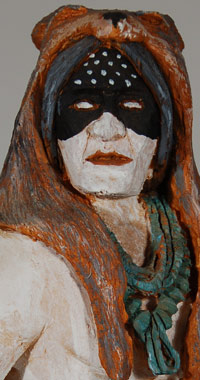 The Navajo legend of skinwalkers:
The Navajo legend of skinwalkers:
"The Navajo skinwalker legend is one of the more complex and terrifying stories, steeped in mystery and evil intent. Many Navajos believe firmly in the existence of skinwalkers and refuse to discuss them publicly for fear of retribution. They believe skinwalkers walk freely among the tribe and secretly transform under the cover of night.
"The term yee naaldooshii literally translates to "with it, he goes on all fours." According to Navajo legend a skinwalker is a medicine man or which (witch) who has attained the highest level of priesthood in the tribe, but chose to use his or her power for evil by taking the form of an animal to inflict pain and suffering on others.
"To become a skinwalker requires the most evil of deeds, the killing of a close family member. They literally become humans who have acquired immense supernatural power, including the ability to transform into animals and other people.
"According to the Navajo skinwalker legend, these evil witches are typically seen in the form of a coyote, owl, fox, wolf or crow — although they do have the ability to turn into any animal they choose.
"Because it is believed that skinwalkers wear the skins of the animals they transform into, it is considered taboo to wear the pelt of any animal. In fact, the Navajo are only known to wear two hides, sheepskin and buckskin, both of which are only used for ceremonial purposes."
Source: navajolegends.org
This all-wood carving of a skinwalker is in the personage of a very muscular and strong individual with good upper body proportions. He is wearing the skin of a wolf draped over his head and a black mask over his eyes. He has a turquoise necklace around his neck, ketohs on both wrists and rings on most fingers. It appears that buckskin is draped over his front somewhat as a loin cloth. Traditional buckskin moccasins complete his dress.
The carving is exceptional. It clearly illustrates that the artist is well versed in the techniques of wood carving. Every part is proportional and beautifully executed. The painting, although minimal, is the work of a true artist.
Condition: appears to be in original condition. There is one finger on the right hand without turquoise but it is not known if that was original or if the stone has fallen off.
Provenance: from the collection of Jan and Chuck Rosenak. Published in Navajo Folk Art by Chuck and Jan Rosenak. 1994, page 60.
Recommended Reading: Navajo Folk Art by Chuck and Jan Rosenak
Title: Navajo (Diné) Folk Art Wood Carving "Skinwalker"
Artist: Lawrence Jacquez (1965- )
Category: Other Items
Origin: Diné - Navajo Nation
Medium: wood, pigments
Size: 15-1/2" sculpture; 19-1/2" with pedestal
Item # C3347L
Title: San Ildefonso Pueblo Original Painting of a Tewa Woman
J. D. Roybal grew up under the artistic influence of his well-known uncle, Awa Tsireh. Early in his education, he studied at St. Catherine's School in Santa Fe and at the Business College of Santa Fe. In the early 1950s he and Julia were married and it was then that he started producing pueblo dance designs on hand-painted Christmas cards and note cards. By 1955 he was seriously painting larger works and recognition for his talents came from the Heard Museum in Phoenix and the Philbrook in Oklahoma. He received a consistent string of first prizes in painting for each year since the Eight Northern Pueblos Arts and Crafts Shows began.
He is mostly known by collectors for his Koshare clown figures, generally in note card size, but he was quite adept at painting larger images and very good at illustrating traditional dance figures and individual people. This painting of a Tewa woman in traditional pueblo clothing and holding a polychrome jar is an extraordinary painting for Roybal. The treatment of her hair is almost identical to that in a painting by Awa Tsireh we had in the past, good evidence of the influence Awa Tsireh had on his nephew. The painting is signed Oquwa in lower right.
Condition: appears to be in original condition but has not been examined out of the frame
Provenance: Adobe Gallery sold this painting to clients in 1989 and now they have brought it back to us for placement in another client's collection for their enjoyment.
Recommended Reading: American Indian Painting of the Southwest and Plains Areas by Dorothy Dunn
Title: San Ildefonso Pueblo Original Painting of a Tewa Woman
Artist: J. D. Roybal (1922-1978) Oquwa-Rain God
Category: Paintings
Origin: San Ildefonso Pueblo
Medium: tempera
Size: 6-1/2" x 4" image; 13-1/8" x 10-5/8" framed
Item # C3349C
Biography: J. D. Roybal (1922-1978) Oquwa-Rain God
J. D. Roybal, whose first name was José, and whose Tewa name was Oquwa (Rain God), was a well-known painter from San Ildefonso Pueblo. He was born on November 7, 1922 at San Ildefonso, the son of Tonita and Juan Cruz Roybal. He passed away June 28, 1978. He was a nephew of Alfonso Roybal (Awa Tsireh).
 He did a bit of painting in the 1930s but was not very productive until the 1950s. He was most productive in the 1960-1970 decade. His most popular subject matter was his rendition of the Tewa Clowns known as Koshare or Koosa. Often he presented them in a jovial manner.
He did a bit of painting in the 1930s but was not very productive until the 1950s. He was most productive in the 1960-1970 decade. His most popular subject matter was his rendition of the Tewa Clowns known as Koshare or Koosa. Often he presented them in a jovial manner.
He used water-based paints throughout his career. His excellent detail in small paintings never went unnoticed. In his work there prevails fine color, excellent detail, small and fine outlines, gesturing figures, and a pleasing combination of heavy conventional themes with realistic subjects.
Title: San Ildefonso Pueblo Original Painting of a Buffalo Dancer
Romando Vigil's Tewa name, Tse Ye Mu means "Falling in Water" or "Falling Cloud." He was born in January 1902 at San Ildefonso Pueblo. He painted infrequently from 1920-1950, and then took a job with Walt Disney Studios. He returned to San Ildefonso and painted for about 10 years before his death in 1978.
 Vigil was one of the San Ildefonso self-taught artists in the early part of the 20th century. He was a leader within the San Ildefonso Watercolor Movement, a movement that caught fire during 1915 to 1917. It fostered an art form unmatched in the culture history of the world. These men portrayed tribal culture and local wildlife, attaining a flat decorative character, absent of backgrounds and foregrounds, and free of traditional perspective, with an unerring color sense. Their success in these presentations was due to their understanding the ceremonials they painted because they had participated in them since childhood. They understood the meanings of the symbolism they interpreted.
Vigil was one of the San Ildefonso self-taught artists in the early part of the 20th century. He was a leader within the San Ildefonso Watercolor Movement, a movement that caught fire during 1915 to 1917. It fostered an art form unmatched in the culture history of the world. These men portrayed tribal culture and local wildlife, attaining a flat decorative character, absent of backgrounds and foregrounds, and free of traditional perspective, with an unerring color sense. Their success in these presentations was due to their understanding the ceremonials they painted because they had participated in them since childhood. They understood the meanings of the symbolism they interpreted.
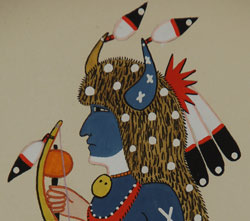 This painting of a Tewa Buffalo Dancer was most likely painted in the last decade of the artist's life. It is much more detailed and better executed than his earlier paintings. Following his return from working at the Walt Disney Studios, he obviously was a much better artist from years of experience and critique. His use of many colors in this painting speaks of his experience in commercial work. This is one of the finest of Vigil's paintings that we have had.
This painting of a Tewa Buffalo Dancer was most likely painted in the last decade of the artist's life. It is much more detailed and better executed than his earlier paintings. Following his return from working at the Walt Disney Studios, he obviously was a much better artist from years of experience and critique. His use of many colors in this painting speaks of his experience in commercial work. This is one of the finest of Vigil's paintings that we have had.
Condition: appears to be in original condition but has not been examined out of the frame
Provenance: Adobe Gallery sold this painting to clients in 1989 and now they have brought it back to us for placement in another client's collection for their enjoyment.
Recommended Reading: American Indian Painting of the Southwest and Plains Areas by Dorothy Dunn
Title: San Ildefonso Pueblo Original Painting of a Buffalo Dancer
Artist: Romando Vigil (1902-1978) Tse Ye Mu - Falling Cloud
Category: Paintings
Origin: San Ildefonso Pueblo
Medium: tempera
Size: 10-1/2" x 6" image; 17-1/2" x 12-1/2" framed
Item # C3349B
Biography: Romando Vigil (1902-1978) Tse Ye Mu - Falling Cloud
 Romando Vigil Tse Ye Mu-Falling Cloud was born on January 23, 1902 (coincidentally, Feast Day at San Ildefonso Pueblo) and passed away in 1978. He was educated at Santa Fe Indian School, and spent a large part of his adult life working at Walt Disney Studio as a (self-taught) painter.
Romando Vigil Tse Ye Mu-Falling Cloud was born on January 23, 1902 (coincidentally, Feast Day at San Ildefonso Pueblo) and passed away in 1978. He was educated at Santa Fe Indian School, and spent a large part of his adult life working at Walt Disney Studio as a (self-taught) painter.
A leader within the San Ildefonso Watercolor Movement, Vigil used a stylized design to represent his chief interest in painting native ceremonial dance figures. He was a master at creating stylized images with a simple line. His work was neatly executed, often without background or foreground treatment. His coloring was usually very good.
Alexander E. Anthony in clay form
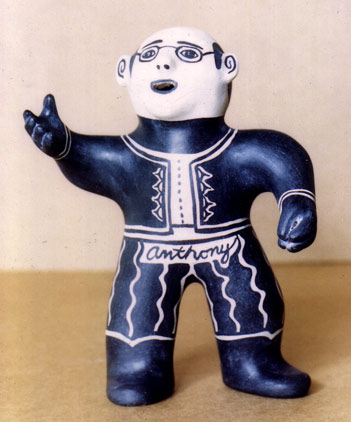
Ever wonder what Alexander E. Anthony, Jr. would look like in clay form? Well, wonder no more. This is a figurine made by Virgil Ortiz. It is part of a group of figurines that paid homage to all of the great art dealers that existed, at the time.
Virgil Ortiz (born 1969) is probably one of the most versatile of all pueblo potters. He makes traditional figurative pottery, experimental figurative pottery, traditional pottery vessels, and, now, designer clothing for Donna Karan.
Title: Pair of Hopi Wood Dance Wands
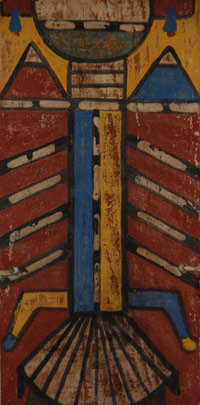 Dance wands of the style of this pair are used by Hopi women when dancing for rain, and are held vertically by the white handles, one in each hand. They are decorated in accordance with the desires of the maker. When being used on the reservation, the top of the wand is covered with downy eagle feathers and sprays of seed grass. Puffs of eagle down are tied with the strings seen on the sides of the wands.
Dance wands of the style of this pair are used by Hopi women when dancing for rain, and are held vertically by the white handles, one in each hand. They are decorated in accordance with the desires of the maker. When being used on the reservation, the top of the wand is covered with downy eagle feathers and sprays of seed grass. Puffs of eagle down are tied with the strings seen on the sides of the wands.
This pair is decorated with images that may be of Muyingwa, the Germination God or Two-Horned God. Muyingwa is not a Katsina, but is a deity. There is a distinction among the Hopi between katsinas and deities. Most deities are never impersonated or even represented by images. Some, however, are represented such as the Germination God deity. This image is not like ones published of Muyingwa so perhaps it is a different deity than indicated.
Muyingwa is the god of reproduction of man, animals and plants. He possesses great knowledge and duties related to agriculture. He ritually insures that plants will sprout for life sustenance. His home is in the underworld.
Condition: The pair of wands is in very good condition, with no observable problems. A metal stand has been fashioned for each so that they display in the upright position.
Provenance: from a collector in New York who purchased them years ago from a reputable dealer so we have no questions regarding the authenticity.
Reference Publications:
Following the Sun and Moon by Alph Secakuku
Hopi Kachina Dolls with a Key to their Identification by Harold Colton
Title: Pair of Hopi Wood Dance Wands
Unknown Maker
Category: Dance Paraphernalia
Origin: Hopi Pueblo
Medium: wood, pigments, string
Size: 17-1/2" tall x 3-3/8" wide; 19-1/4" tall with stand
Item # C3345
Title: Navajo Folk Art Carving “Grandma in Blue with Coke Can”
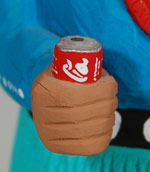 Harrison Juan describes the inspiration for his innovative and distinctive current style as follows: "I was at an art show and I saw myself in the sunglasses of a collector, and I got the idea of carving people wearing glasses like that. I could capture their likeness and place them in their environment all at one time."
Harrison Juan describes the inspiration for his innovative and distinctive current style as follows: "I was at an art show and I saw myself in the sunglasses of a collector, and I got the idea of carving people wearing glasses like that. I could capture their likeness and place them in their environment all at one time."
Juan is a nephew of folk art artist Johnson Antonio and remembers cutting wood for his uncle and running errands for him. It was his influence that was the motivation for Juan to start carving. He works from cottonwood he finds along the creek beds of the San Juan River. It is his hope to work full time as an artist, but has found it necessary to work construction jobs as well.
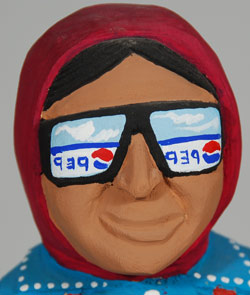 "I just try to keep it going," the artist explains, "showing the joys of reservation life and Navajo people at gatherings, ceremonies, and just the fun of friends being together at local posts. I carve the older people and show how they are dressed (wrapped in colorful trade blankets, sometimes called Pendleton's, and sporting their best jewelry)." Many are wearing his signature sunglasses. Captured in their reflection are groups of neighbors and friends and perhaps a glimpse of clear Western skies and surrounding scenery of the reservation.
"I just try to keep it going," the artist explains, "showing the joys of reservation life and Navajo people at gatherings, ceremonies, and just the fun of friends being together at local posts. I carve the older people and show how they are dressed (wrapped in colorful trade blankets, sometimes called Pendleton's, and sporting their best jewelry)." Many are wearing his signature sunglasses. Captured in their reflection are groups of neighbors and friends and perhaps a glimpse of clear Western skies and surrounding scenery of the reservation.
This carving of a Navajo grandmother with her long flowing pleated skirt and signature velveteen blouse with silver buttons on the bodice and sleeves is shown holding a can of Coca Cola while in her sunglasses is a reflection of Pepsi. She is wearing a two-strand coral necklace and traditional moccasins. The carving is signed by the artist on the underside and was completed in the 1980s.
Condition: original condition
Provenance: from the collection of Jan and Chuck Rosenak.
Recommended Reading: Navajo Folk Art by Chuck and Jan Rosenak
Title: Navajo Folk Art Carving "Grandma in Blue with Coke Can"
Artist / Carver: Harrison Juan (1953-present)
Category: Other Items
Origin: Diné - Navajo Nation
Medium: wood, pigments
Size: 14-1/2" tall x 5-1/2" diameter of base
Item # C3347J
News Release: Alexander E. Anthony, Jr. turns 80
News Release: Congratulations to Alexander E. Anthony, Jr. who is celebrating his 80th Birthday! Owner of Adobe Gallery, now in its 35thyear, is showing no signs of slowing down. Flowers and birthday wishes are flowing in from all parts of the globe. If you want to let him know how he's influenced you over the years, call or send an email.
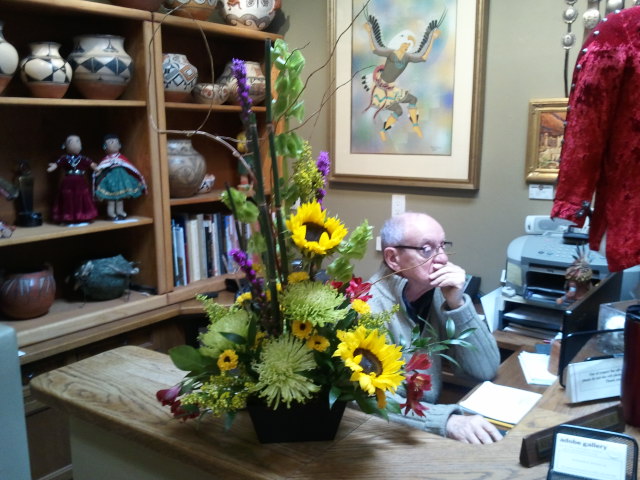
One Bedroom Santa Fe New Mexico Vacation Rental
Conveniently Located Santa Fe Vacation Rental - a one-bedroom condominium Santa Fe vacation rental. It may be rented either short-term or long-term at rates substantially below comparable units. There are many things to do in Santa Fe! This Santa Fe Vacation Rental is conveniently located within walking distance of a local coffee shop and bookstore, Canyon Road, Adobe Gallery, the Santa Fe Plaza, Lensic Theater, Museum Hill and most other attractions and restaurants in the heart of Santa Fe. This location increases the possibility of a group of friends and/or family members being here at the same time and being close together.
 The Hacienda at Garcia Street, One Bedroom Condo
The Hacienda at Garcia Street, One Bedroom Condo
Private and quiet, this beautiful, modern one bedroom, one bath, 850 square foot condo located in the prestigious and historic Santa Fe's Eastside neighborhood. This condominium has been furnished with all new kitchen appliances, beautiful and comfortable furnishings to include large screen flat panel TV, free wireless Internet access and free local/long-distance telephone. All bedding, linens, towels, toiletries, etc. are conveniently and professionally provided. Additional maid service is available during your stay, if needed. Our local grocery store is also within walking distance or can be delivered to your door. Private, dedicated, convenient parking is provided.
This Santa Fe Vacation Rental is owned and managed by Alexander E. Anthony, Jr., owner of Adobe Gallery. This is the person you will be dealing with when renting this beautiful vacation rental. Living next door provides immediate attention to any questions or requirements during your stay.
Title: Ohkay Owingeh Original Painting of Horses
Ascensión Trujillo lived only to the age of 26 years so he probably did not produce very many paintings. This is the only one we have ever had in the gallery. Trujillo attended the Santa Fe Indian School in 1953 followed by attendance at the University of New Mexico. His attendance at the Indian School was after the tenure of art teacher Dorothy Dunn so his is not of The Studio style.
 There are only two public collections containing his art, which is not surprising since his career was so short. The Red Cloud Indian School in Pine Ridge, South Dakota, and the Heard Museum in Phoenix, Arizona, are the only two institutions listed as having his paintings. He apparently had exhibits at the Red Cloud Indian School, Museum of New Mexico, Millicent Rogers Museum in Taos and the Philbrook Art Center in Tulsa, quite an accomplishment for such a young artist. He received awards from the Museum of New Mexico and the Philbrook.
There are only two public collections containing his art, which is not surprising since his career was so short. The Red Cloud Indian School in Pine Ridge, South Dakota, and the Heard Museum in Phoenix, Arizona, are the only two institutions listed as having his paintings. He apparently had exhibits at the Red Cloud Indian School, Museum of New Mexico, Millicent Rogers Museum in Taos and the Philbrook Art Center in Tulsa, quite an accomplishment for such a young artist. He received awards from the Museum of New Mexico and the Philbrook.
Trujillo was an extraordinarily talented young man. His rendition of the horses in this painting is very well done as is the choice of colors. The trees in the background are solid and firm and the grasses in the foreground are lively as if dancing in the wind. Overall, the artist had a very good grasp of plants and animals and executed both with a talented hand.
Condition: appears to be in original condition but has not been examined out of the frame
Provenance: Adobe Gallery sold this painting to clients in 1989 and now they have brought it back to us for placement in another client's collection for their enjoyment.
Title: Ohkay Owingeh Original Painting of Horses
Artist: Ascensión Trujillo (1933-1959) Poquin Tahn
Category: Paintings
Origin: Ohkay Owingeh Pueblo (San Juan)
Medium: tempera on paper
Size: 17-3/4" x 23-3/4" image; 24-3/4" x 30-3/4" framed
Item # C3349A
Title: Navajo (Diné) Folk Art Carving “Blessing Way—Hózhó”
After completing the equivalent of middle school, Jacquez (pronounced Hackus) went to work in construction but an accident ended that career after just a short while. Jacquez recalled that he had been painting on and off his whole life so he began to paint more seriously. His paintings related to Navajo ceremonial sand paintings. A terrible automobile accident, at the hands of a drunk driver near the Nageezi Trading Post, took the lives of Jacques's mother, two sisters, son, and daughter. This horrendous event changed his life and affected his art.
The artist somewhat blamed himself for this loss because he had broken Navajo taboo by painting sacred ceremonial imagery sand paintings. But, after giving it considerable thought, he decided he had nothing more to lose by continuing this art form so he began to carve such scenes in three-dimensional form, accurately depicting the Yeis and ceremonies.
This diorama entitled Blessing Way-Hózhó depicts a healing ceremony. I believe the Blessing Way is a 9-day ceremony. The female is sitting on a Navajo medicine man-created healing sand paining. The Grandfather Yei is ministering to her. It is my understanding that as the patient sits on the sand painting; the sickness leaves her and is absorbed by the sandpainting which then is destroyed before sunset.
The Navajo ceremonial basket on the floor contains sands of various colors that are used in creating the sandpainting. There are also eagle feathers and a medicine bag in the basket. A stone metate for preparation of medicines sits on the floor, next to which are a sea shell, a stick, and a pair of eagle feathers. The medicine man is holding a feather in his right hand and a medicine bag in his left. Surrounding the patient is a series of feathers standing upright in the soil.
The medicine man is dressed in full traditional clothing. He has a fox tail attached to his belt on the rear and he wears a deer skin draped over his lower body. His jewelry consists of a concha belt, bracelet, turquoise rings and a Ketoh on his left wrist. A complete fox skin is wrapped around his neck and a leather medicine bag hangs on his left hip. He is wearing leather moccasins with woven sashes wrapped around their tops.
The patient wears a full skirt and traditional moccasins with leg wraps. She is bare on top. In her hands are eagle feathers and on her wrists are elaborate turquoise and silver bracelets, rings on fingers, a concha belt around her waist and a beautiful nugget turquoise necklace with jaclas around her neck. Her long hair hangs down in front and covers her breasts.
The diorama is signed on underside Blessing Way-Hózhó © L. Jacquez '06.
Condition: original condition
Provenance: from the collection of Jan and Chuck Rosenak. Published in Navajo Folk Art by Chuck and Jan Rosenak. 1994, page 61.
Recommended Reading: Navajo Folk Art by Chuck and Jan Rosenak
Title: Navajo (Diné) Folk Art Carving "Blessing Way-Hózhó"
Artist / Carver: Lawrence Jacquez (1965- )
Category: Other Items
Origin: Diné - Navajo Nation
Medium: wood, pigments
Size: 14-1/2" x 10" base; 8-3/4" tall
Item # C3347F
Title: Original Painting “Autumn Cottonwoods, Rio Grande”
Arthur William Hall was a Texan by birth but spent his childhood in Oklahoma and Virginia. He attended the Chicago Art Institute, where he met his future wife, Norma Bassett. His early art career was interrupted by World War I during which he served in southern France. His exposure to France at that time resulted in the Halls going to Europe in 1925 where they stayed for two years. It was in Europe that Hall was exposed to the etching process, a technique he would continue throughout his art career and for which he is most famous.
In 1944, the Halls moved to Santa Fe, New Mexico, and settled in a two-hundred year old adobe house and studio that was the former home of artist Gerald Cassidy. They remained in Santa Fe until 1950 at which time they moved to a small village between Santa Fe and Taos.
Norma Bassett Hall passed away in 1957 and Hall remarried in 1963. From that time until his death in 1981, Hall worked exclusively in watercolor.
This watercolor of cottonwoods at the Rio Grande in autumn was probably painted during the few years that the Halls lived on Canyon Road in Santa Fe—1944-1950—because there is a gallery label on verso that reads 922 Canyon Road, Santa Fe, New Mexico. The painting is in a hand-carve wood frame that is original to the painting.
Condition: appears to be in original condition but has not been examined out of the frame.
Provenance: from an art collector in Albuquerque
Title: Original Painting "Autumn Cottonwoods, Rio Grande"
Artist: Arthur W. Hall (1889-1981)
Category: Paintings
Origin: European-American Artists
Medium: watercolor
Size: 11-3/8" x 18-3/8" image; 19-3/4" x 27-3/8" framed
Item # C3346B


